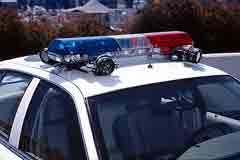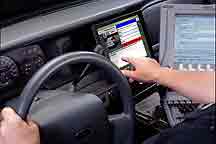As a police officer pulls behind a speeding, a camera mounted on the patrol car has already automatically read its license plate. This information is then processed by an on-board computer. Within seconds, the displays shows that the car is stolen and the occupants are wanted for a murder. Or an Amber Alert goes out for an abducted child.

Officers in ALPR equipped patrol cars enter the abductorÃs license plate number into their systems, and the cameras start reading plates of all vehicles on the freeway.
This mobile ALPR capability is now available in the U.S. The Mobile Plate Hunter 900 is offered by Remington-Elsag Law Enforcement Systems and the Automatic License Plate Recognition system comes from Motorola and PIPS Technology. Besides reading plates much faster than is humanly possible, they eliminate the need for an officer to manually type in a license number and request a database search for each number.
Thus, they significantly reduce the recognition time, officer workload and errors. Best of all, officers can drive with both hands on the wheel and both eyes on the road performing regular patrol duties while the ALPR system operates.
The Mobile Plate Hunter 900 is the result of a partnership between U.S. gun manufacturer, Remington, and Italian postal-technology company, Elsag. The system is based on optical character-recognition technology developed for the Italian post office for reading handwriting at 90 mph. This ALPR system has been used by the Italian Carabinieri for about three years and is now installed on about 3,000 Italian police vehicles.
The infrared (IR) cameras for MPH 900 fit in the top light bars or are attached to the roof by magnetic clips. The two IR only need a fraction of a second to recognize a plate on vehicles parked or in motion. The camera first identifies potential license plates and then scans the numbers. The software translates the data on the plate into a digital image, checks it versus an onboard hotlist, and returns an alarm back to the operator in milliseconds if an interdiction is warranted.
The Mobile Plate Hunter 900 works at patrol and highway speeds - oncoming differential speeds of in excess of 120 mph and passing speeds in excess of 75 mph. Whether the patrol car is moving or stopped, the camera continuously scans to the left and right, recording every license plate it sees. Cameras can read up to four lanes of traffic with a single vehicle. Officers can read 8-10,000 plates in just one shift. The system works in daylight or at night.

MotorolaÃs Automatic License Plate Reader using PAGIS (Police ALPR Graphical Interface System) technology developed by PIPS Technology in England. The system uses two Dual Lens Cameras controlled by the operator via the PAGIS software user interface. One camera Lens uses visible light to take an overview image of the vehicle and the other lens uses IR illumination to capture the license plate.
The ALPRÃs IR Camera/Illuminator provides both scene illumination and image capture in one unit so an additional light source is not needed. The system provides reliable performance at vehicle speeds up to 120 mph in a variety of lighting settings including total darkness, oncoming headlights, bright sunlight, low sun, deep shadows and glare.
When a vehicle passes through the field of view, the microprocessor will output the license plate information together with time, date, lane number and other required information, plus a captured image. The PAGIS software then searches the databases to check if the plate is listed. Even with millions of records in the database, PAGIS can return a match in a fraction of a second.
These ALPR systems are currently not inexpensive - about $20,000 for each mobileinstallation. However, as is the case with most electronics, prices are expected to drop asmore are put into service. Both of the companies, as well as several others, offer the technology for stationary installations. These applications range from facility access control and toll payment systems to enforcement of traffic laws.




